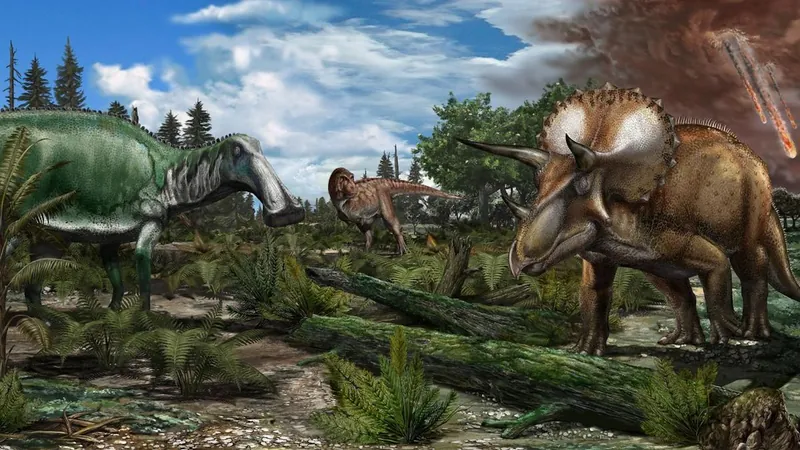
Shocking Revelation: Dinosaurs Were Thriving Before The Asteroid Catastrophe, New Study Unveils!
2025-04-08
Author: Mei
A groundbreaking study challenges the long-held belief that dinosaurs were on a downward spiral before the catastrophic asteroid impact 66 million years ago. Contrary to popular assumptions, researchers now argue that dinosaurs were thriving and not facing extinction prior to this monumental event. This astonishing finding is based on a comprehensive analysis of nearly 18 million years' worth of fossil evidence, shedding new light on a debate that has persisted for over three decades.
For years, fossil discoveries had led many scientists to speculate that a decline in dinosaur numbers and diversity was evident before the asteroid collision, which marked the end of the Cretaceous period. This notion suggested that these magnificent creatures were already on their way out, a theory that not only raised eyebrows but also fueled intense debate among paleontologists.
Chris Dean, a paleontologist at University College London and the lead author of the study, explained, "The question has lingered: Were dinosaurs already doomed before the asteroid hit?" Recent research published in the journal *Current Biology* presents vital evidence that might fundamentally alter our understanding of dinosaur extinction.
The team's in-depth investigation focused on fossil records from North America, specifically during the Campanian and Maastrichtian ages, examining nearly 8,000 fossil specimens across four notable families: Ankylosauridae, Ceratopsidae, Hadrosauridae, and Tyrannosauridae.
While initial analyses indicated a peak in dinosaur diversity around 76 million years ago, followed by a decline leading up to the asteroid impact, the researchers noted no apparent environmental factors that could explain this decrease. In fact, the study suggests that all examined dinosaur families were widespread and thriving, rendering them low-risk for extinction—until that fateful asteroid strike.
A significant revelation from the research highlights the potential impact of geological conditions on fossilization. During the Maastrichtian period, the environment may not have favored fossil preservation. Major geological events, like the retreat of the Western Interior Seaway and the uplift of the Rocky Mountains, could have disrupted fossil deposition, misleading scientists into believing that dinosaur diversity was waning when it may have simply been harder to find fossil evidence.
Moreover, the study points out that much of the geological material from the Maastrichtian in North America was either buried under vegetation or not well-exposed, limiting access to potential dinosaur fossil sites. Since North America hosts half of the known fossils from this time, the implications of these findings could be far-reaching, perhaps affecting our understanding of dinosaur evolution on a global scale.
Importantly, the analysis found that Ceratopsians, including iconic horned dinosaurs like Triceratops, were the most common fossils discovered, likely due to their ability to thrive in open terrains conducive to fossil preservation. In contrast, Hadrosaurians, known as the duck-billed dinosaurs, were found less frequently—perhaps reflecting their predilection for riverine habitats affected by fluctuating water levels.
This study adds a compelling chapter to the ongoing saga of dinosaur history, igniting new discussions about the resilience of these creatures in the face of environmental change. With such pivotal revelations, the narrative of dinosaur extinction is poised for a dramatic rewrite. Could it be that if it weren't for that fateful asteroid, dinosaurs might have continued to roam the Earth for millions of years to come? Only further research will tell. Stay tuned!




 Brasil (PT)
Brasil (PT)
 Canada (EN)
Canada (EN)
 Chile (ES)
Chile (ES)
 Česko (CS)
Česko (CS)
 대한민국 (KO)
대한민국 (KO)
 España (ES)
España (ES)
 France (FR)
France (FR)
 Hong Kong (EN)
Hong Kong (EN)
 Italia (IT)
Italia (IT)
 日本 (JA)
日本 (JA)
 Magyarország (HU)
Magyarország (HU)
 Norge (NO)
Norge (NO)
 Polska (PL)
Polska (PL)
 Schweiz (DE)
Schweiz (DE)
 Singapore (EN)
Singapore (EN)
 Sverige (SV)
Sverige (SV)
 Suomi (FI)
Suomi (FI)
 Türkiye (TR)
Türkiye (TR)
 الإمارات العربية المتحدة (AR)
الإمارات العربية المتحدة (AR)